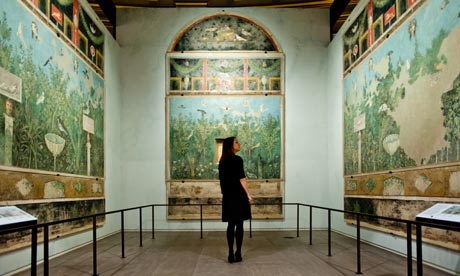This week I had a turbo boosted visit to the British Museum in order to prepare for two courses that may or may not become reality, since there are the minimum enrolment levels in place. Nevertheless, I decided – like every time – that preparing is better than being ‘thrown to the lions’ at the last minute. In this case the preparation was educational anyway, since the exhibitions on show – Life and death in Pompeii and Herculaneum and Ice Age Art – are both top quality and presenting material you rarely see in one place. This week I discuss the Pompeii exhibition and return to the Ice Age next week.
Naturally, with Pompeii and Herculaneum you could see most of this material or similar finds together with the standing remains, if you visit the Bay of Napoli area. One could also travel to see some of the other places mentioned in the map presenting the areas and sites affected by the eruption, namely Misenum, Oplontis, Boscoreale and Stabiae. However, even if the British Museum has some painting fragments from the area in its collections, you do not normally get this kind of measured presentation anywhere outside the major exhibitions.
The exhibition makes quite a lot out of the difference in destruction between the two cities, the topic of the Margaret Mountford documentary the other week. Although the documentary started on the wrong foot with me – I just cannot take these ‘endlessly prompted mystery tours’ presented as serious documentaries any more – the actual facts are fascinating. The end result in the Bay of Naples was the same; the towns and their remaining inhabitants were destroyed and wiped from the face of the Earth, but the events took different turns.
After the superheated column of gasses and debris shot up in the sky 20 miles high, the people of Pompeii had a reasonable change of taking the quick exit along the routes to the south or north. They were luckier, if they avoided the coast and headed to the north, since the winds blew to the south. While a 400-degree-hot pyroclastic surge evaporated the inhabitants of Herculaneum, the Pompeians first got only ash and stones raining on them. The final hot surge there came only after the night of terrors. This was the reason why the bodies in Pompeii rotted under the volcanic layers, whereas in Herculaneum the whole population was wiped out and all organic matter was carbonated. Herculaneum is also covered by a 20-metre bed of debris, whereas in Pompeii the cover is only 4 metres. The lure of sculpture after the tunnelling at Herculaneum reached the remains was a huge draw for different parties. After all, the sites belonged to the king of Naples who used the material as diplomatic gifts alongside collecting.
The exhibition was arranged like a Roman house. We first approached the street front of the house after seeing an introductory movie and were presented with the information of different trades and shops along the roads. Then we stepped into the atrium, where we were face to face to one of the busts of the Pompeians, the head of one Lucius Caecilius Iucundus. Material from his house popped up here and there in the exhibition and gave a kind of continuum to the presentations as did the domus shape of the rooms. The centre piece of the exhibition was the bird frescos from the garden room of the House of the Golden Bracelet. I did think about Antero Tammisto and his PhD on the bird species in Pompeii when checking the information boards with the bird and plant species. Apart from these the real draw were the beautifully preserved carbonated pieces of furniture that were the unusual sight in a Roman exhibition. The huge chests, the delicate cot that reminded of the whole populations disappearing, and food items all preserved with their details, showed how similar some of the everyday was during the Roman times.
There were small items that were surprisingly modern. We were presented a whole window glass and different plumbing fittings that looked very modern indeed. The sun dial could have decorated any garden in Britain – or one of the gardens of continental 17th-century castles. The erotic aspect was presented with proper taste. The emphasis was on the way these figures and sculptures shocked the 19th-century sensibilities and were quickly locked away only to re-emerge in 2000 from the Gabinetto degli oggetti riservati.
I did not buy the audio or multimedia guide, since I wanted to concentrate on the exhibition and what it was telling me. However, I saw plenty of youngsters confidently swiping their mobile phone like aids in order to hear and see the information on the correct object with its number shown on the wall. The audio guide had also interviews from Mary Beard, Amanda Claridge and Andrew Wallice-Hadrill as an added bonus.
The exhibition finished with the famous casts and the hour by hour countdown of the events in the Bay of Naples. The casts, especially the one of the whole family, were a powerful reminder of the horrors of being suffocated when potentially blocked into your own house. The warped forms and the physical changes together with the ‘boxer’ position resulted from the heat contracting the tendons of the body. When you see one cast, you may not wonder why they had taken this position, since the coming ‘avalance’ would be enough to make you raise your hands. Now when you saw a family together and the whole thing explained, you could see what the document on the television was all about.
Powerful, beautiful and educational. Definitely worth the entrance fee.


No comments:
Post a Comment